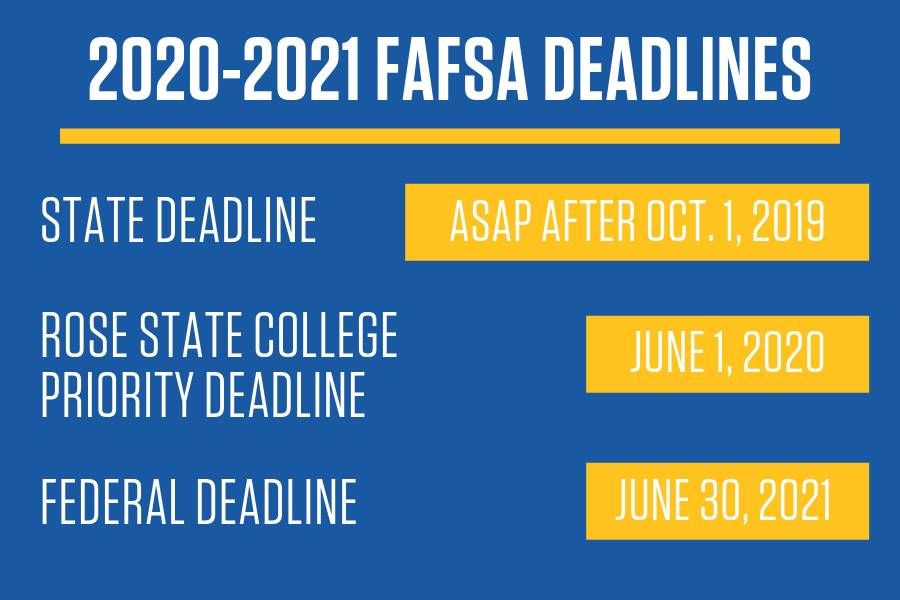The Rose State Guide to the 2020-2021 FAFSA Published October 3, 2019
 When applying for student aid, it can be difficult to know where to begin. Luckily, when it comes to receiving federal aid from the U.S. Department of Education (ED), the process is pretty straightforward. The FAFSA form for the 2020-2021 school year will become available October 1, 2019. Now is the perfect time to start thinking about federal student aid for next school year so you can start your application as soon as possible
When applying for student aid, it can be difficult to know where to begin. Luckily, when it comes to receiving federal aid from the U.S. Department of Education (ED), the process is pretty straightforward. The FAFSA form for the 2020-2021 school year will become available October 1, 2019. Now is the perfect time to start thinking about federal student aid for next school year so you can start your application as soon as possible
Never applied for federal aid or filled out the FAFSA before? We’ve broken down all of the information you need to apply for student federal aid.
What is the FAFSA?
FAFSA stands for Free Application for Federal Student Aid. Using this application, college students in the United States can apply for federal student aid offered by the ED to help cover expenses such as tuition, fees, room and board, books, supplies, transportation, and even related expenditures like computers.
The FAFSA is free to complete and gives students access to the largest source of financial aid to pay for college. In fact, the ED awards more than $120 billion a year in federal student aid in the form of grants, work-study funds, and loans. In addition to making you eligible to receive federal aid, the FAFSA can determine your eligibility for state aid and school aid. Some private federal aid providers also use FAFSA information to award aid.
Eligibility Requirements for Federal Student Aid
If you believe you’re not eligible to receive federal student aid, think again. Almost every student who meets basic eligibility requirements can receive aid, regardless of your age or family income. To receive aid after filling out the FAFSA, you must:
- Be a U.S. citizen or eligible non-citizen
- Demonstrate financial need (for most programs)
- Have a Social Security number
- Be registered with Selective Service (if you’re a male between ages 18 and 25)
- Be enrolled or accepted for enrollment in an eligible degree or certificate program at Rose State
- Be enrolled as a Rose State student
- Maintain satisfactory academic standings while at Rose State
- Sign the certification statement on the FAFSA stating that you are not in default on a federal student loan, do not owe money on a federal student grant, and will only use federal student aid for educational purposes
- Show you’re qualified to obtain a college education by having a high school diploma or GED certification (or a state-recognized equivalent)
If you’d like to estimate the amount of aid you could potentially receive, visit sutdentaid.gov/fafsa/estimate.
FAFSA Deadlines for 2020-2021
The FAFSA form for the 2020-2021 school year will open on October 1, 2019. It is recommended that you apply for federal aid as soon as possible, as some funding is limited and awarded on a first-come, first-served basis.
The state of Oklahoma does not have an official deadline, but suggests students submit the FAFSA as soon as possible in order to receive state-awarded aid. While the final federal deadline for completing the FAFSA is June 30, 2021, you must have your FAFSA completed and turned into the Rose State Financial Aid Office by June 1, 2020 in order to receive priority consideration for the Fall 2020 semester. For the Spring 2021 semester, you’re FAFSA must be turned into the Financial Aid Office by October 1, 2020 to receive priority consideration.
Filling Out the 2020-2021 FAFSA Form
It’s best to gather all necessary information before beginning to fill out the FAFSA form. If you’re considered a dependent student, you’ll need the following information for your parents as well as yourself. If you’re married, you’ll need your spouse’s information in addition to your own.
For the 2020-2021 FAFSA, you’ll need:
- Social Security number
- Student’s driver’s license (if applicable)
- 2018 tax return for you and your parents, if applicable
- Bank statements, records of investment, and records of untaxed income (i.e. veteran’s non-education benefits and child support)
- A FSA ID to electronically sign the form
It’s important to get your FSA ID before you fill out the FAFSA because you may have to wait up to three days after registering to use the ID. If you are considered a dependent student, both you and your parents will need your own unique FSA IDs to sign the electronic application.
Once you’ve gathered all the necessary information, it’s time to start the application. You’ll first be asked to identify yourself as either: A. a student or B. a parent, preparer, or student from a Freely Associated State. If you’re a student, your personal information (like your name, Social Security number, date of birth, etc.) will automatically load into your application.
Thanks to a partnership with the IRS, filling out your financial information is a lot easier than it used to be. Both students and parents may be able to automatically transfer the necessary information from their 2018 tax return into the 2020-2021 FAFSA using the IRS Data Retrieval Tool. If you are not given this option when filling out the FAFSA, simply input this information using your physical tax return. Even if you do use the IRS tool, some of your financial information may not be transferred to your application, so make sure to double check each field.
When asked to enter your college’s FAFSA school code, enter Rose State’s code: 009185.
Free help is available during the application process at StudentAid.gov or 1-800-4-FED-AID (1-800-433-3243). If you still have questions about filling out the FAFSA, contact Rose State’s Financial Aid office or check out the help topics at studentaid.gov.
Types of Federal Aid Available through FAFSA
There are several types of federal aid you can receive by filling out the FAFSA, including grants, work-studies, and loans. The types of federal student aid available to Rose State students are detailed below.
Grants
Federal Pell Grant – A Federal Pell Grant does not have to be repaid and is available to undergraduates with financial need. For the 2019-2020 school year, this grant may be awarded up to $6,195 per student.
Federal Supplemental Education Opportunity Grant (FSEOG) – The FSEOG does not have to be repaid and is awarded to students with exceptional financial need. Federal Pell Grant recipients take priority for the grant.
Oklahoma Tuition Aid Grant (OTAG) – Legal residents of Oklahoma may be eligible for the OTAG as determined by the state’s Oklahoma Tuition Aid Grant Office. The maximum award for the OTAG is $1,000 per student for those attending public colleges.
Work-Study
Federal Work-Study – Through a Federal Work-Study, students earn money that does not need to be repaid. The work-study is comprised of part-time jobs on campus.
Loans
Direct Subsidized Loan – Direct Subsidized Loans are available to undergraduate students who have financial need. Maximum loan amounts are $3,500 per year for students who have completed fewer than 30 credit hours and $4,500 per year for students who have more than 30 credit hours.
Direct Unsubsidized Loan – Direct Unsubsidized Loans are available to students enrolled at least half-time, and financial need is not required.
Direct PLUS Loan – Direct PLUS Loans are awarded to parents of undergraduate students. The student must be enrolled at least half-time and financial need is not required. The maximum amount that can be received is the cost of school attendance minus any other aid awarded.
What Happens After You Apply
After you’ve completed the application, you will receive a Student Aid Report (SAR). Review this carefully to ensure all information you entered is correct, as incorrect information can hinder your ability to receive aid promptly. The SAR will provide instructions to make changes, if necessary.
The amount of federal aid you receive is dependent on your Expected Family Contribution (EFC), your year in school, your enrollment status, and the cost of tuition. For directions on how to check the status of your financial aid application, visit Rose State’s financial aid status checker.
The Rose State College Financial Aid Office will review your financial aid application to determine the types and amount of aid you may be eligible to receive. You will then receive a financial aid notification with detailed award information.
If you have been awarded aid, the Financial Aid Office will provide information on how and when your aid will be distributed. Typically, your aid is first applied toward your tuition, fees, and room and board (if applicable). If any money is left over, it will be paid to you for other education-related expenses.
Follow these instructions to accept or decline any aid you have received as well as sign a Master Promissory Note (MPN) and complete loan entrance counseling.
Contact the Financial Aid Office at finaid@rose.edu or (405) 733-7424 with any questions you may have about federal student aid.
For helpful resources from the U.S. Department of Education, visit studentaid.gov.



